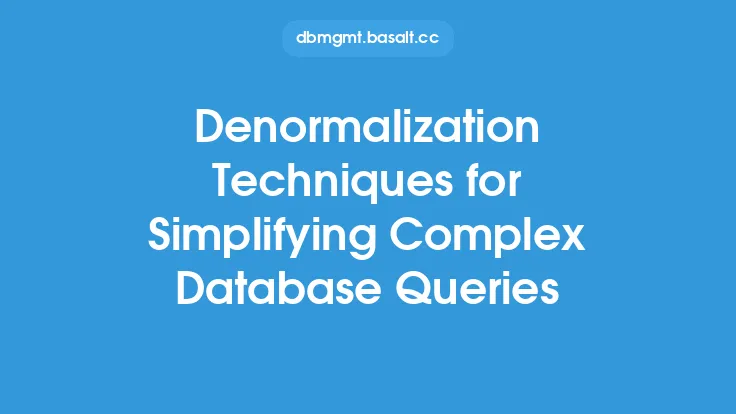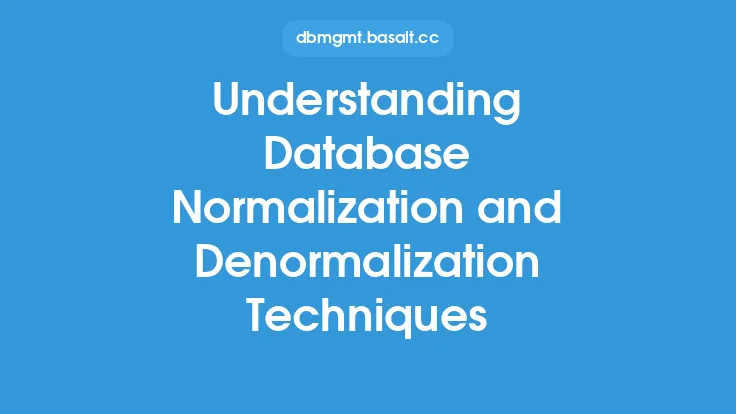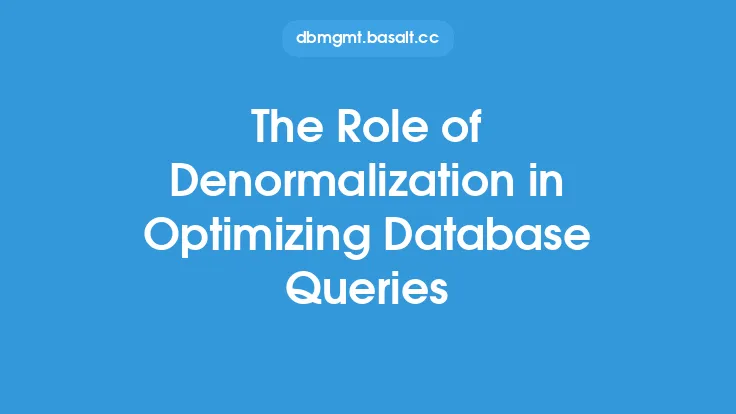Database denormalization is a technique used in database design to improve the performance of a database by intentionally deviating from the principles of database normalization. Normalization is the process of organizing data in a database to minimize data redundancy and dependency, which helps to improve data integrity and scalability. However, in some cases, denormalization can be beneficial, especially in systems that require high performance and fast data retrieval.
Introduction to Denormalization
Denormalization involves deliberately duplicating data or grouping data in a way that reduces the number of joins required to retrieve data, thereby improving query performance. This technique is often used in databases that support high-traffic applications or systems that require fast data retrieval, such as e-commerce websites, social media platforms, or real-time analytics systems. Denormalization can be applied to various aspects of database design, including table structure, indexing, and data storage.
Types of Denormalization
There are several types of denormalization techniques, each with its own advantages and disadvantages. Some common types of denormalization include:
- Data Duplication: This involves duplicating data in multiple tables to reduce the number of joins required to retrieve data. For example, in a customer database, the customer's address might be duplicated in both the customer table and the order table to avoid joining the two tables.
- Data Aggregation: This involves pre-calculating and storing aggregated data, such as sums or averages, to reduce the need for complex calculations at query time. For example, in a sales database, the total sales for each region might be pre-calculated and stored in a separate table to avoid having to calculate it at query time.
- Data Partitioning: This involves dividing large tables into smaller, more manageable pieces based on a specific criteria, such as date or region. This can improve query performance by reducing the amount of data that needs to be scanned.
- Indexing: This involves creating indexes on columns that are frequently used in queries to improve query performance. Indexes can be created on a single column or on multiple columns.
Benefits of Denormalization
Denormalization can provide several benefits, including:
- Improved Query Performance: Denormalization can improve query performance by reducing the number of joins required to retrieve data, pre-calculating aggregated data, and creating indexes on frequently used columns.
- Increased Scalability: Denormalization can help to improve scalability by reducing the load on the database and improving query performance, which can help to support high-traffic applications.
- Simplified Data Retrieval: Denormalization can simplify data retrieval by reducing the complexity of queries and improving data locality, which can make it easier to retrieve data.
Challenges of Denormalization
While denormalization can provide several benefits, it also presents several challenges, including:
- Data Consistency: Denormalization can make it more difficult to maintain data consistency, as changes to data may need to be made in multiple places.
- Data Redundancy: Denormalization can lead to data redundancy, which can make it more difficult to manage data and ensure data integrity.
- Increased Storage Requirements: Denormalization can require more storage space, as duplicated data can increase the overall size of the database.
Best Practices for Denormalization
To get the most out of denormalization, it's essential to follow best practices, including:
- Carefully Evaluate the Need for Denormalization: Denormalization should only be used when necessary, as it can introduce complexity and data redundancy.
- Use Denormalization Techniques Judiciously: Denormalization techniques should be used judiciously, as over-denormalization can lead to data redundancy and consistency issues.
- Monitor and Maintain Data Consistency: It's essential to monitor and maintain data consistency when using denormalization, as changes to data may need to be made in multiple places.
- Use Indexing and Caching: Indexing and caching can be used to improve query performance and reduce the load on the database.
Tools and Technologies for Denormalization
Several tools and technologies can be used to support denormalization, including:
- Database Management Systems: Most database management systems, such as MySQL, Oracle, and Microsoft SQL Server, support denormalization techniques, such as data duplication, data aggregation, and indexing.
- Data Warehousing Tools: Data warehousing tools, such as Amazon Redshift, Google BigQuery, and Microsoft Azure Synapse Analytics, can be used to support denormalization and improve query performance.
- NoSQL Databases: NoSQL databases, such as MongoDB, Cassandra, and Couchbase, can be used to support denormalization and improve query performance.
- Cloud-Based Services: Cloud-based services, such as Amazon Web Services, Microsoft Azure, and Google Cloud Platform, can be used to support denormalization and improve query performance.
Conclusion
Denormalization is a powerful technique that can be used to improve the performance of a database by intentionally deviating from the principles of database normalization. While denormalization can provide several benefits, including improved query performance, increased scalability, and simplified data retrieval, it also presents several challenges, including data consistency, data redundancy, and increased storage requirements. By carefully evaluating the need for denormalization, using denormalization techniques judiciously, monitoring and maintaining data consistency, and using indexing and caching, database administrators can get the most out of denormalization and improve the performance of their databases.





